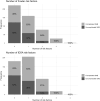The Utility of Risk Factors to Define Complicated Staphylococcus aureus Bacteremia in a Setting With Low Methicillin-Resistant S. aureus Prevalence
- PMID: 38157401
- PMCID: PMC11006106
- DOI: 10.1093/cid/ciad784
The Utility of Risk Factors to Define Complicated Staphylococcus aureus Bacteremia in a Setting With Low Methicillin-Resistant S. aureus Prevalence
Abstract
Introduction: Recommended duration of antibiotic treatment of Staphylococcus aureus bacteremia (SAB) is frequently based on distinguishing uncomplicated and complicated SAB, and several risk factors at the onset of infection have been proposed to define complicated SAB. Predictive values of risk factors for complicated SAB have not been validated, and consequences of their use on antibiotic prescriptions are unknown.
Methods: In a prospective cohort, patients with SAB were categorized as complicated or uncomplicated through adjudication (reference definition). Associations and predictive values of 9 risk factors were determined, compared with the reference definition, as was accuracy of Infectious Diseases Society of America (IDSA) criteria that include 4 risk factors, and the projected consequences of applying IDSA criteria on antibiotic use.
Results: Among 490 patients, 296 (60%) had complicated SAB. In multivariable analysis, persistent bacteremia (odds ratio [OR], 6.8; 95% confidence interval [CI], 3.9-12.0), community acquisition of SAB (OR, 2.9; 95% CI, 1.9-4.7) and presence of prosthetic material (OR, 2.3; 95% CI, 1.5-3.6) were associated with complicated SAB. Presence of any of the 4 risk factors in the IDSA definition of complicated SAB had a positive predictive value of 70.9% (95% CI, 65.5-75.9) and a negative predictive value of 57.5% (95% CI, 49.1-64.8). Compared with the reference, IDSA criteria yielded 24 (5%) false-negative and 90 (18%) false-positive classifications of complicated SAB. Median duration of antibiotic treatment of these 90 patients was 16 days (interquartile range, 14-19), all with favorable clinical outcome.
Conclusions: Risk factors have low to moderate predictive value to identify complicated SAB and their use may lead to unnecessary prolonged antibiotic use.
Keywords: Staphylococcus aureus bacteremia; complicated bacteremia; risk factors; treatment.
© The Author(s) 2023. Published by Oxford University Press on behalf of Infectious Diseases Society of America.
Conflict of interest statement
Potential conflicts of interest. M. J. B. reports funding from Janssen Vaccines, Novartis, CureVac, Merck, Takeda, Sanofi, Spherecydes, Pfizer, and AstraZeneca for unrelated works. C. H. W. reports funding from DaVolterra, bioMérieux, LimmaTech, Merck/MSD, and Sanofi-Pasteur for unrelated works. A. G. reports Netherlands Government Grants paid to Amsterdam UMC (2021: Government grant to investigate COVID-19 vaccine immunogenicity for hematological patients and 2021: Government grant to investigate heterologous COVID-19 vaccination strategies in healthcare workers) and speaker fees from Springer Healthcare (2023: invited speaker on infectious diseases), all for work unrelated to this project. M. B. reports grants from Janssen Vaccines and Merck, consulting fees from Merck, Shionogi, and Spherecydes, and participation on a Data Safety Monitoring Board or Advisory Board for Sanofi all for work unrelated to this project and paid to UMC Utrecht. B. A. L. reports a role as Member of Supervisory Board Orange Babies Charity. All other authors report no potential conflicts. All authors have submitted the ICMJE Form for Disclosure of Potential Conflicts of Interest. Conflicts that the editors consider relevant to the content of the manuscript have been disclosed.
Figures



References
-
- Fowler VG Jr, Olsen MK, Corey GR, et al. Clinical identifiers of complicated Staphylococcus aureus bacteremia. Arch Intern Med 2003; 163:2066–72. - PubMed
-
- Liu C, Bayer A, Cosgrove SE, et al. Clinical practice guidelines by the Infectious Diseases Society of America for the treatment of methicillin-resistant Staphylococcus aureus infections in adults and children. Clin Infect Dis 2011; 52:e18–55. - PubMed
-
- Verduin K, Ammerlaan H, Blaauw G, et al. Dutch guidelines on the treatment of Staphylococcus aureus bacteraemia. 2019. Available at: https://richtlijnendatabase.nl/richtlijn/staphylococcus_aureus_bacteriem....
Publication types
MeSH terms
Substances
Grants and funding
LinkOut - more resources
Full Text Sources
Medical

